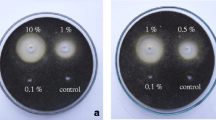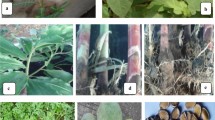Abstract
In this study, four species of Alternaria as A. alternata (Fr.) Keissler, A. solani (Sorauer), A. tenuissima (Kunze) Wiltshire and A. zinniae M.B. Ellis were detected in seed samples of zinnia collected from the commercial lots in Egypt. Koch’s postulates performed in pots under greenhouse conditions proved that only A. zinniae was the main causal pathogen of leaf spot. Moreover, it was frequently detected in all seed components of coat, cotyledon, and embryo. Disease severity induced by all isolates of A. zinniae was highly related to growth stages of zinnia, where it increased with the development of plant age from 1 to 8 weeks old. Transmission of A. zinniae infected seed to seedling was at 51.3% (blotter method), whereas using seedling symptom test and test tube agar method exhibited infected seedling of 58.5 and 55.8%, respectively. In the efficacy test of extracts from different materials of thuja against A. zinniae performed in vitro, leaf methanol and water extracts were the most effective treatments, where they completely inhibited spore germination at a concentration of (5 and 3%, respectively) and mycelial growth at (7 and 7%, respectively) followed by seed methanol and water extracts. In the field experiments conducted during 2016 and 2017, a highly significant reduction in the percent of leaf area infected with A. zinniae of zinnia occurred after seeds were treated by soaking in methanol extracts of 3% leaf and 7% seed for 15 min before sowing. Hence, there is a scope to integrate thuja leaf and seed extracts as plant-derived agents for eco-friendly management of A. zinniae on zinnia.


Similar content being viewed by others
References
Agrios GN (1997) Plant pathology. 4th edition, 635 p
Anonymous (1996) International rules for seed testing. Seed Science and Technology, Association, 68–72 p
Assadi M (1998) Flora of Iran, Nos. 19D22: Pinaceae, Taxaceae, Cupressaceae and Ephedraceae. Institute of Forests and Rangelands, Tehran, p 11D12
Assawah MW, Elarosi H (1959) An Alternaria leaf spot of Zinnia. Alex J Agric Res 7(2):93–101
Baker KF (1980) Pathology of flower seed. Seed Sci Technol 8(4):575–589
Dimock A, Osborn JH (1943) An Alternaria disease of zinnia. Phytopathology 3:372–381
Domsch KH, Gams W, Anderson TH (1980) Compendium of soil fungi. Volume 1. Academic Press, London
Duhan JS, Saharan P, Surekha KA (2013) Antimicrobial potential of various fractions of Thuja orientalis. Afr J Microbiol Res 7(25):3179–3186
El-Shazly AMA (2000) Antifungal activity of some essential oils on fungi causing damping-off diseases of maize. Al-Azhar J Agric Res 31(6):95–107
Farrag Eman S, Moharam MHA (2012) Pathogenic fungi transmitted through cucumber seeds and safely elimination by application of peppermint extract and oil. Not Sci Biol 4(3):83–91
Gambogi P, Triolo E, Vannacci G (1976) Experiments on the behavior of the seedborne fungus Alternaria zinniae. Seed Sci Technol 4:333
Gomez KA, Gomez AA (1984) Statistical procedures for agricultural research, 2nd edn. Willey, New York (NY)
Guleria S, Kumar A (2006) Antifungal activity of some Himalayan medicinal plants using direct bioautography. J Cell Mol Biol 5:95–98
Guleria S, Kumar A, Tikua AK (2007) Chemical composition and Fungitoxic activity of essential oil of Thuja orientalis L. grown in the North-Western Himalaya. Z Naturforsch 63:211–214
Guleria S, Kumar A, Tikua AK (2008) Chemical composition and fungitoxic activity of essential oil of Thuja orientalis L. Grown in the North-Western Himalaya. Z Naturforsch 63c:211–214
Hegazi MA, El-Kot GA (2010) Biological control of powdery mildew on zinnia (Zinnia elegans L.) using some biocontrol agents and plant extracts. J Agric Sci 2(4):221–229
Hong SG, Barry BM (2004) Development of selective media for the isolation and enumeration of Alternaria species from soil and plant debris. Can J Microbiol 50:461–468
Jain RK, Garg SC (1997) Antimicrobial activity of the essential oil of Thuja orientalis L. Anc Sci Life 16(3):186–189
Khare MN (1996) Methods to test seeds for associated fungi. Indian Phytopathol 49:319–328
Lipschutz L (1965) The resistance of Zinnia species to Alternaria zinniae Pape. M.S. Thesis. Pa. State Univ., USA
Maden S, Singh D, Mathur SB, Neergard P (1975) Detection and location of seed borne inoculum of Ascochyta rabei and its transmission in chickpea. Seed Sci Technol 3:667–671
Manandhar JB, Hartman GL, Sinclair JB (1988) Soybean germplasm evaluation for resistance to Colletotricum truncatum. Plant Dis 72:56–59
Mishra M, Malik S, Tiwari, SN (1992) Allelopathic effect of certain botanicals against six fungal pathogens of rice. Proceedings of First National Symposium on Alleolo-pathy in Agroecosystems (Agriculture and Forestry), 191–193
Moharam MHA, Ali HAO (2012) Preventative and curative effects of several plant derived agents against powdery mildew disease of okra. Not Sci Biol 4(3):76–82
Moharam MHA, Stephan D, Koch E (2018) Evaluation of plant-derived preparations and microorganisms as seed treatments for control of covered kernel smut of sorghum (Sporisorium sorghi). J Plant Dis Prot 125:159–166
Pane C, Villecco D, Roscigno G, De Falco E, Zaccardelli M (2013) Screening of plant-derived antifungal substances useful for the control of seed borne pathogens. Arch Phytopathol Plant Protect 46(13):1533–1539
Richardson MJ (1990) An annotated list of Seedborne disease. ISTA Secretariat, Zurich
Rotem J (1994) The genus Alternaria: biology, epidemiology and pathogenicity. The American Phytopathological Society, 326 pp.
Seehachai W, Sangchote S (2009) Seed transmission of Alternaria zinniae, causing leaf spot in zinnia. Proceedings of the 47th Kasetsart University annual conference, Kasetsart, 17-20 March 2009, pp., 498-505
Simmons EG (1995) Alternaria themes and variations (112-144). Mycotaxon 55:55–163
Srivastava Priya, Kumar P, Singh DK, Singh VK (2012) Biological properties of Thuja Orientalis Linn. Advances in Life Sciences 2(2):17–20
Susan S, Stevens AB, Gast KIB, O’Mara JA, Tisserat NA, Bauernfeind R (1993) Commercial specialty cut flower production: zinnias. Kansas State University
Wehlburg C (1969) Two leaf spot diseases of zinnia. Plant Pathology Circular No 86: 1–2
Acknowledgments
The authors are thankful to all members of Experimental Farm and Laboratories, Faculty of Agriculture, Sohag University for financial support to carry out the research work.
Author information
Authors and Affiliations
Corresponding author
Rights and permissions
About this article
Cite this article
Moharam, M.H.A., Soliman, Y.M.Y. Antifungal activity of Thuja orientalis against transmittedseed-borne Alternaria zinniae, causing leaf spot disease in zinnia (Zinnia elegans L.). Australasian Plant Pathol. 48, 583–594 (2019). https://doi.org/10.1007/s13313-019-00661-z
Received:
Accepted:
Published:
Issue Date:
DOI: https://doi.org/10.1007/s13313-019-00661-z




